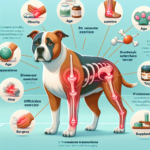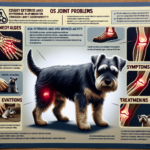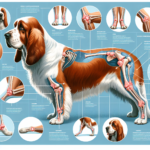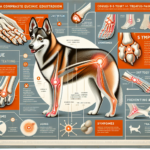Flat-Coated Retriever Joint Pain: Causes, Symptoms, Prevention, and Treatment
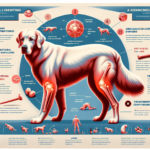
Introduction
The Flat-Coated Retriever is a versatile and energetic breed known for its friendly demeanor and striking appearance. Originating in the United Kingdom during the 19th century, this breed was initially developed for retrieving game both on land and in water. With a sleek, black or liver-colored coat and a joyful, outgoing personality, the Flat-Coated Retriever has become a beloved companion and a skilled working dog.
Despite their robust and active nature, Flat-Coated Retrievers are prone to certain health issues, with joint pain being a significant concern. Joint health is crucial for this breed, given their high activity levels and the physical demands placed on their bodies. Understanding the causes, symptoms, prevention, and treatment of joint pain in Flat-Coated Retrievers is essential for ensuring their long-term well-being and quality of life.
Breed-Specific Joint Pain Risks
Genetic Predisposition
Flat-Coated Retrievers, like many other large breeds, are genetically predisposed to joint-related issues. Common conditions include hip dysplasia, elbow dysplasia, and arthritis. Hip dysplasia occurs when the hip joint does not fit properly into the hip socket, leading to pain and mobility issues. Elbow dysplasia involves abnormal development of the elbow joint, causing lameness and discomfort. Arthritis, a degenerative joint disease, can develop as a result of these conditions or independently, leading to chronic pain and stiffness.
Age-Related Risks
As Flat-Coated Retrievers age, the risk of developing joint pain increases. While young dogs may show early signs of joint issues, symptoms often become more pronounced as they reach middle age and beyond. Owners should be vigilant about monitoring their dogs for signs of joint pain, particularly as they approach the age of seven or eight, when age-related joint degeneration becomes more common.
Activity Level and Joint Stress
Flat-Coated Retrievers are known for their high energy levels and love of physical activity. Whether they are participating in hunting, agility, or simply enjoying a vigorous game of fetch, their joints are subjected to significant stress. While regular exercise is essential for their overall health, excessive or inappropriate activity can exacerbate joint issues. Owners must strike a balance between keeping their dogs active and preventing undue strain on their joints.
Common Symptoms of Joint Pain in Flat-Coated Retrievers
General Symptoms
- Limping: One of the most noticeable signs of joint pain is limping or favoring one leg over another.
- Stiffness: Dogs may exhibit stiffness, particularly after periods of rest or in the morning.
- Reluctance to Move: A dog in pain may be hesitant to engage in activities they once enjoyed, such as running or climbing stairs.
- Swelling: Swelling around the joints can be a visible indicator of inflammation and pain.
- Behavioral Changes: Irritability, lethargy, or changes in appetite can also signal discomfort.
Breed-Specific Symptoms
In Flat-Coated Retrievers, joint pain may manifest in specific ways due to their unique physical and behavioral characteristics. For instance, their boundless enthusiasm may make it difficult to notice subtle signs of pain. Owners should pay close attention to any changes in their dog’s gait, willingness to play, or overall demeanor. Additionally, given their predisposition to hip and elbow dysplasia, symptoms related to these joints should be closely monitored.
When to Consult a Vet
If a Flat-Coated Retriever exhibits any signs of joint pain, it is crucial to consult a veterinarian promptly. Early intervention can prevent further deterioration and improve the dog’s quality of life. Specific red flags that warrant a vet visit include persistent limping, noticeable swelling, severe stiffness, or any sudden changes in behavior or activity levels.
Preventive Measures for Joint Health
Exercise Recommendations
Regular exercise is vital for maintaining joint health in Flat-Coated Retrievers, but it must be appropriate for their age and condition. Low-impact activities such as swimming are excellent for building muscle without putting excessive strain on the joints. Controlled walks and gentle play sessions can also help keep them active without exacerbating joint issues. Avoid high-impact activities like jumping or running on hard surfaces, especially for dogs with known joint problems.
Dietary Suggestions
A balanced diet rich in essential nutrients can support joint health. Foods containing glucosamine and chondroitin can help maintain cartilage health, while omega-3 fatty acids have anti-inflammatory properties that can alleviate joint pain. Owners should consider high-quality commercial dog foods formulated for joint health or consult their veterinarian about appropriate supplements.
Weight Management
Maintaining a healthy weight is crucial for reducing joint stress in Flat-Coated Retrievers. Excess weight can exacerbate joint pain and lead to further complications. Owners should monitor their dog’s weight closely and adjust their diet and exercise routine as needed to prevent obesity. Regular vet check-ups can help ensure the dog remains within a healthy weight range.
Early Screening and Monitoring
Early screening for joint issues can help catch problems before they become severe. Regular veterinary check-ups should include assessments of joint health, particularly for breeds like the Flat-Coated Retriever that are prone to joint problems. X-rays and other diagnostic tools can identify early signs of dysplasia or arthritis, allowing for timely intervention.
Treatment Options for Joint Pain
Non-Surgical Treatments
Non-surgical treatments for joint pain in Flat-Coated Retrievers include medications, physical therapy, and lifestyle adjustments. Anti-inflammatory drugs and pain relievers can help manage symptoms, while physical therapy can improve mobility and strengthen muscles around the joints. Lifestyle changes such as modifying exercise routines and providing supportive bedding can also alleviate discomfort.
Surgical Options
In severe cases, surgical intervention may be necessary. Common surgeries for joint pain include hip replacement, arthroscopy, and corrective osteotomies. These procedures can significantly improve a dog’s quality of life, but they come with risks and require a thorough discussion with a veterinarian. Post-surgical care is crucial for successful recovery and long-term joint health.
Alternative Therapies
Alternative therapies such as acupuncture, hydrotherapy, and massage can provide additional relief for dogs with joint pain. Acupuncture can reduce pain and inflammation, while hydrotherapy offers low-impact exercise that strengthens muscles without stressing the joints. Massage therapy can improve circulation and alleviate muscle tension, contributing to overall joint health.
Lifestyle and Management Tips
Daily Care Routine
A consistent daily care routine can help manage joint pain in Flat-Coated Retrievers. This routine might include gentle exercise, a balanced diet, and regular administration of any prescribed medications or supplements. Monitoring the dog’s behavior and adjusting activities based on their comfort level is essential for maintaining their well-being.
Modifying the Home Environment
Making the home environment more comfortable for a dog with joint pain can significantly improve their quality of life. Consider using ramps instead of stairs, providing orthopedic beds for better support, and ensuring that food and water bowls are at an accessible height. Non-slip mats can also prevent falls and reduce the risk of injury.
Long-Term Management
Long-term management of joint pain involves ongoing monitoring and adjustments to the dog’s care routine. Regular veterinary check-ups, weight management, and appropriate exercise are key components. Owners should remain vigilant for any changes in their dog’s condition and be prepared to modify their care plan as needed to ensure their dog remains active and happy.
FAQs About Flat-Coated Retrievers and Joint Pain
What are the early signs of joint pain in Flat-Coated Retrievers?
Early signs of joint pain include limping, stiffness, reluctance to move, and behavioral changes such as irritability or lethargy. Owners should also watch for swelling around the joints and any noticeable changes in the dog’s gait.
Can joint pain in Flat-Coated Retrievers be prevented?
While it may not be possible to prevent joint pain entirely, taking preventive measures such as maintaining a healthy weight, providing appropriate exercise, and ensuring a balanced diet can significantly reduce the risk. Early screening and regular veterinary check-ups are also crucial for catching issues early.
Are there specific exercises that are better for Flat-Coated Retrievers with joint pain?
Low-impact exercises such as swimming and controlled walks are ideal for Flat-Coated Retrievers with joint pain. These activities help maintain muscle strength and joint flexibility without putting excessive strain on the joints.
What dietary supplements can help with joint health in Flat-Coated Retrievers?
Supplements containing glucosamine, chondroitin, and omega-3 fatty acids can support joint health. These nutrients help maintain cartilage health and reduce inflammation. Always consult a veterinarian before adding supplements to your dog’s diet.
When should I consider surgical options for my dog’s joint pain?
Surgical options should be considered when non-surgical treatments are no longer effective, and the dog’s quality of life is significantly impacted. A thorough discussion with a veterinarian is essential to understand the risks and benefits of surgery.
Conclusion
Joint pain is a significant concern for Flat-Coated Retrievers, given their genetic predisposition and high activity levels. Understanding the causes, symptoms, prevention, and treatment options is crucial for ensuring their long-term health and happiness. By taking proactive measures such as maintaining a healthy weight, providing appropriate exercise, and seeking early veterinary intervention, owners can help their Flat-Coated Retrievers lead active and pain-free lives. Regular consultations with a veterinarian are essential for monitoring joint health and making informed decisions about care and treatment.

